Highly Sensitive Amperometric Sensor Based on Laccase-Mimicking Metal-Based Hybrid Nanozymes for Adrenaline Analysis in Pharmaceuticals
Abstract
:1. Introduction
2. Results and Discussion
2.1. Synthesis and Characterization of the NLacs
2.2. The Development and Characterization of the NZ-Modified Electrodes
2.3. Characterization of the Most Effective nAuCePt-Based Electrode and Its Application
3. Materials and Methods
3.1. Reagents
3.2. Isolation and Purification of Laccase
3.3. Synthesis and Characterization of Laccase-like NZs
3.4. Apparatus, Measurements, and Statistical Analysis
3.5. Functionalization and Characterization of the Electrodes
3.6. Determination of AD in Pharmaceutical Formulation
4. Conclusions
Author Contributions
Funding
Acknowledgments
Conflicts of Interest
Abbreviations
| ABTS | 2:2′-Azinobis-(3-ethylbenzthiazoline-6-sulphonate) |
| AD | Adrenaline |
| CV | Cyclic voltammetry |
| GCE | Glassy-carbon electrode |
| GE | Graphite electrode |
| Imax | Maximal current response on tested analyte at substrate saturation |
| KMapp | Apparent Michaelis–Menten constant |
| LOD | Limit of detection |
| LR | Linear range |
| NPs | Nanoparticles |
| NZ | Nanozyme |
| Me1/Me2 | Core/shell Nanozyme; where Me1—core and Me2—shell |
| Laccase | Natural laccase from Trametes gibbosa 1525 |
| SAT | Standard addition test |
| SEM-XRM | Scanning electron microscopy coupled with X-ray microanalysis |
| PtE | Platinum-rod electrode |
| PPy-PVS | Polypyrrole–polyvinylsulphonate; |
| GCE | Glassy-carbon electrode; |
| IrOx/SPE | Iridium-oxide modified screen-printed electrode; |
| Pt-BMI.PF6 | PtNPs in 1-butyl-3-methylimidazolium hexafluorophosphate; |
| CPE | Carbon-paste electrode |
| EBNBH | 2,2-[1,2-ethanediylbis(nitriloethylidyne)]-bis-hydroquinone double-wall carbon-nanotube; |
| GCE | Glassy-carbon electrode |
| MWCNT/CFE | Carbon film electrode (CFE) modified with multiwalled carbon-nanotubes (MWCNTs) |
| AuNPs/PANi/GCE | Gold nanoparticles/polyaniline Langmuir-modified glassy-carbon electrode. |
References
- Akerman-Sanchez, G.; Rojas-Jimenez, K. Fungi for the bioremediation of pharmaceutical-derived pollutants: A bioengineering approach to water treatment. Environ. Adv. 2021, 4, 100071. [Google Scholar] [CrossRef]
- Massima Mouele, E.S.; Tijani, J.O.; Badmus, K.O.; Pereao, O.; Babajide, O.; Zhang, C.; Shao, T.; Sonin, E.; Tarasenko, V.; Fatoba, O.O.; et al. Removal of Pharmaceutical Residues from Water and Wastewater Using Dielectric Barrier Discharge Methods—A Review. Int. J. Environ. Res. Public Health 2021, 18, 1683. [Google Scholar] [CrossRef]
- Rebollar-Pérez, G.; Campos-Terán, J.; Ornelas-Soto, N.; Méndez-Albores, A.; Torres, E. Biosensors based on oxidative enzymes for detection of environmental pollutants. Biocatalysis 2016, 1, 118–129. [Google Scholar] [CrossRef]
- USGS.gov. Available online: https://toxics.usgs.gov/highlights/PMFs.html (accessed on 18 November 2021).
- Rana, R.S.; Singh, P.; Kandari, V.; Singh, R.; Dobhal, R.; Gupta, S. A review on characterization and bioremediation of pharmaceutical industries’ wastewater: An Indian perspective. Appl. Water Sci. 2017, 7, 1–12. [Google Scholar] [CrossRef] [Green Version]
- Taylor, D. The Pharmaceutical Industry and the Future of Drug Development. In Pharmaceuticals in the Environment; Hester, R.E., Harrison, R.M., Eds.; Royal Society of Chemistry: London, UK, 2015; Volume 41, pp. 1–33. Available online: www.rsc.org (accessed on 10 December 2021).
- McCorry, L.K. Physiology of the Autonomic Nervous System. Am. J. Pharm. Educ. 2007, 71, 78. [Google Scholar] [CrossRef] [Green Version]
- Peaston, A.E.; Evsikov, A.V.; Graber, J.H.; Vries, W.N.; Holbrook, A.E.; Solter, D.; Knowles, B.B. Retrotransposons regulate host genes in mouse oocytes and preimplantation embryos. Dev. Cell. 2004, 7, 597–606. [Google Scholar] [CrossRef] [PubMed]
- Emamzadeh, F.N.; Surguchov, A. Parkinson’s Disease: Biomarkers, Treatment, and Risk Factors. Front. Neurosci. 2018, 12, 612. [Google Scholar] [CrossRef]
- Zuber, S.M.; Kantorovich, V.; Pacak, K. Hypertension in Pheochromocytoma: Characteristics and Treatment. Endocrinol. Metab. Clin. N. Am. 2011, 40, 295–311. [Google Scholar] [CrossRef] [PubMed] [Green Version]
- Thomas, A.; Geyer, H.; Mester, H.J.; Schänzer, W.; Zimmermann, E.; Thevis, M. Quantitative Determination of Adrenaline and Noradrenaline in Urine Using Liquid Chromatography-Tandem Mass Spectrometry. Chromatographia 2006, 64, 587–591. [Google Scholar] [CrossRef]
- Bibire, N.; Christopoulos, L.; Apostu, M.; Dorneanu, V. Quantitative determination of adrenaline by visible spectrophotometric method. Rev. Med. Chir. Soc. Med. Nat. Iasi. 2007, 111, 779–782. [Google Scholar] [PubMed]
- Liu, C.; Zhang, J.; Zhang, X.; Zhao, L.; Shuang, L. Enantiomeric separation of adrenaline, noradrenaline, and isoprenaline by capillary electrophoresis using streptomycin-modified gold nanoparticles. Mikrochim. Acta 2018, 185, 227. [Google Scholar] [CrossRef]
- Menon, S.; Jesny, S.; Sivasankaran, U.; Girish, K.K. Fluorometric Determination of Epinephrine: A Green Approach. Anal. Sci. 2016, 32, 999–1001. [Google Scholar] [CrossRef] [Green Version]
- A Kojło, A.; Calatayud, J.M. Spectrophotometric determination of adrenaline with an oxidative column in a FIA assembly. J. Pharm. Biomed. Anal. 1990, 8, 663–666. [Google Scholar] [CrossRef]
- Beitollahi, H.; Safaei, M.; Tajik, S. Voltammetric and amperometric sensors for determination of epinephrine: A short review (2013–2017). J. Electrochem. Sci. Eng. 2019, 9, 27–43. [Google Scholar] [CrossRef]
- Quan, D.; Shin, W. Amperometric Detection of Catechol and Catecholamines by Immobilized Laccase from DeniLite. Electroanalysis 2004, 16, 1576–1582. [Google Scholar] [CrossRef]
- Arslan, F.; Durmus, S.; Colak, O.; Arslan, H. A New Laccase-Based Biosensor for Epinephrine Determination. Gu. J. Sci. 2015, 28, 1–9. [Google Scholar]
- Zou, L.; Li, Y.; Cao, S.; Ye, B. Gold nanoparticles/polyaniline Langmuir-Blodgett Film modified glassy carbon electrode as voltammetric sensor for detection of epinephrine and uric acid. Talanta 2013, 117, 333–337. [Google Scholar] [CrossRef] [PubMed]
- Salimi, A.; Alizadeh, V.; Compton, R.G. Disposable amperometric sensor for neurotransmitters based on screen-printed electrodes modified with a thin iridium oxide film. Anal. Sci. 2005, 21, 1275–1280. [Google Scholar] [CrossRef] [Green Version]
- Brondani, D.; Scheeren, C.W.; Dupont, J.; Vieira, I.C. Biosensor based on platinum nanoparticles dispersed in ionic liquid and laccase for determination of adrenaline. Sens. Actuators B Chem. 2009, 140, 252–259. [Google Scholar] [CrossRef]
- Beitollahi, H.; Ardakani, M.M.; Ganjipour, B.; Naeimi, H. Novel 2,2-[1,2-ethanediylbis(nitriloethylidyne)]-bis-hydroquinone double-wall carbon nanotube paste electrode for simultaneous determination of epinephrine, uric acid and folic acid. Biosen. Bioelectron. 2008, 24, 362–368. [Google Scholar] [CrossRef] [PubMed]
- Ghica, M.E.; Brett, C.M.A. Simple and efficient epinephrine sensor based on carbon nanotube modified carbon film electrodes. Anal. Let. 2013, 46, 1379–1393. [Google Scholar] [CrossRef]
- Ni, J.A.; Ju, H.X.; Chen, H.Y.; Leech, D. Amperometric determination of epinephrine with an osmium complex and Nafion double-layer membrane modied electrode. Anal. Chim. Acta 1999, 378, 151–157. [Google Scholar] [CrossRef]
- Agboola, B.O.; Ozoemena, K.I. Efficient electrocatalytic detection of epinephrine at gold electrodes with self-assembled metallo-octacarboxyphthalocyanine complexes. Electroanalysis 2008, 20, 1696–1707. [Google Scholar] [CrossRef]
- Shankar, S.S.; Shereema, R.M.; Rakhi, R.B. Electrochemical Determination of Adrenaline using MXene/Graphite composite paste electrodes. ACS Appl. Mater. Interfaces 2018, 50, 43343–43351. [Google Scholar] [CrossRef]
- Xu, H.; Wang, X.; Chen, R.; Yu, Z. Voltammetric Determination of Epinephrine in the Presence of Uric Acid Based on Aminated Graphene and Ag NPs Hybrid Membrane Modified Electrode. Chem. Res. Chin. Univ. 2014, 30, 205–210. [Google Scholar] [CrossRef]
- Turkušić, E.; Redžić, S.; Kahrović, E.; Zahirović, A. Electrochemical Determination of Adrenaline at Ru(III) Schiff Base Complex Modified Carbon Electrodes. Croat. Chem. Acta 2017, 90, 345–352. [Google Scholar] [CrossRef]
- Stasyuk, N.; Gayda, G.; Andriy Zakalskiy, A.; Zakalska, O.; Serkiz, R.; Gonchar, M. Amperometric biosensors based on oxidases and PtRu nanoparticles as artificial peroxidase. Food Chem. 2019, 285, 213–220. [Google Scholar] [CrossRef]
- Demkiv, O.M.; Gayda, G.Z.; Broda, D.; Gonchar, M.V. Extracellular laccase from Monilinia fructicola: Isolation, primary characterization and application. Cell Biol. Intern. 2021, 45, 536–548. [Google Scholar] [CrossRef]
- Stasyuk, N.; Gayda, G.; Demkiv, O.; Darmohray, L.; Gonchar, M.; Nisnevitch, M. Amperometric biosensors for L-arginine determination based on L-arginine oxidase and peroxidase-like nanozymes. Appl. Sci. 2021, 11, 7024. [Google Scholar] [CrossRef]
- Gayda, G.Z.; Demkiv, O.M.; Gurianov, Y.; Serkiz, R.Y.; Klepach, H.M.; Gonchar, M.V.; Nisnevitch, M. “Green” Prussian Blue Analogues as Peroxidase Mimetics for Amperometric Sensing and Biosensing. Biosensors 2021, 11, 193. [Google Scholar] [CrossRef]
- Demkiv, O.; Stasyuk, N.; Serkiz, R.; Gayda, G.; Nisnevitch, M.; Gonchar, M. Peroxidase-Like Metal-Based Nanozymes: Synthesis, Catalytic Properties, and Analytical Application. Appl. Sci. 2021, 11, 777. [Google Scholar] [CrossRef]
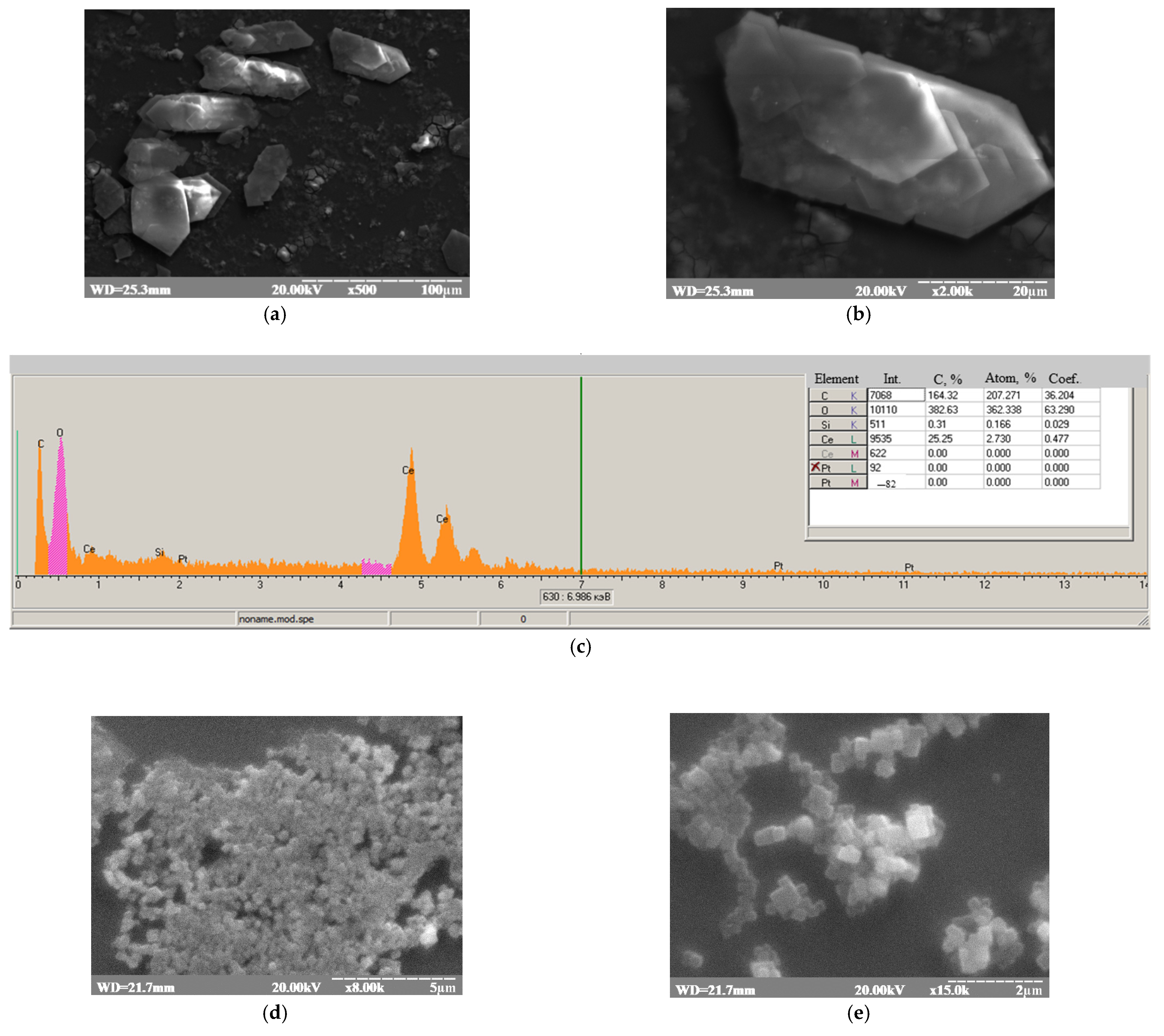


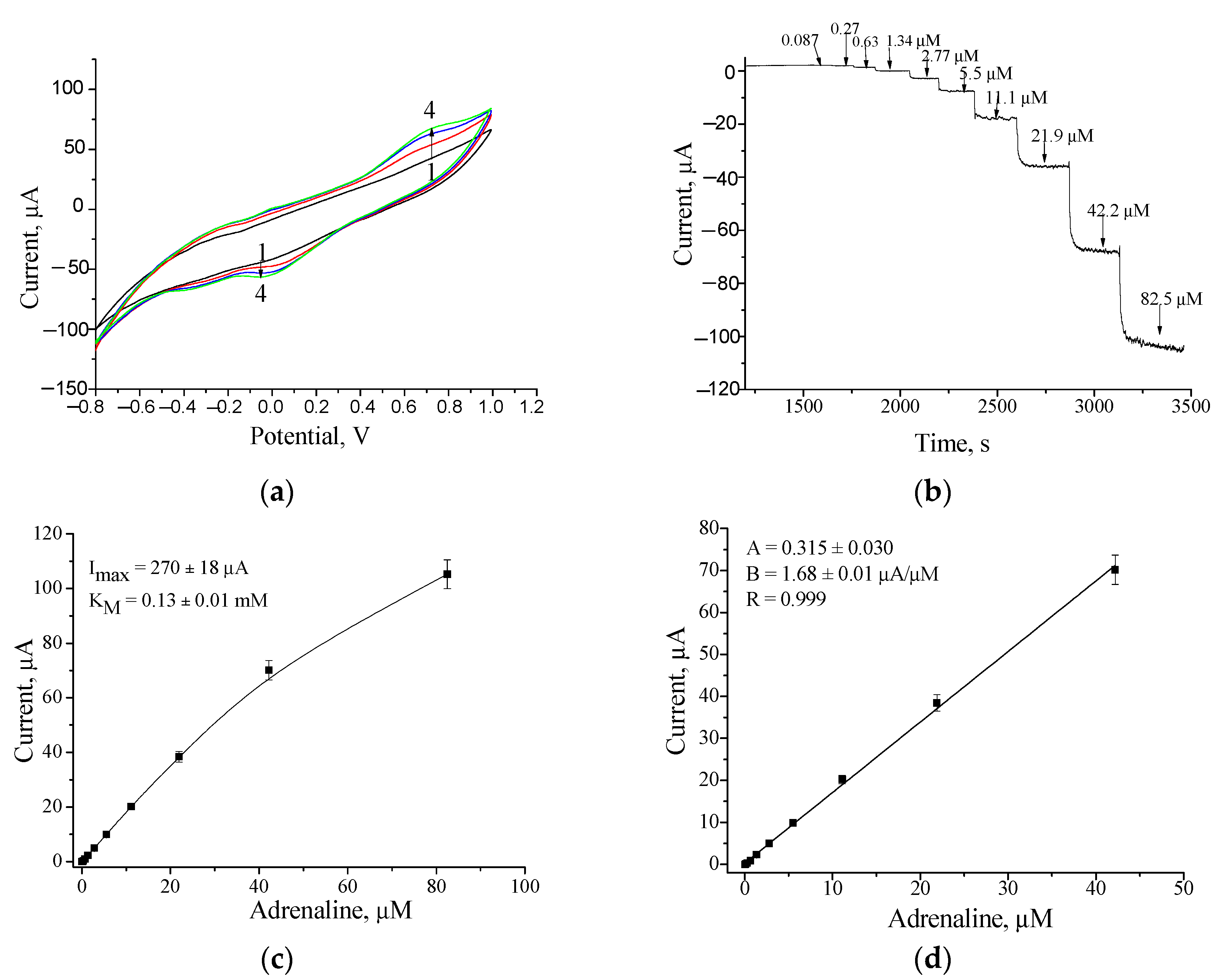
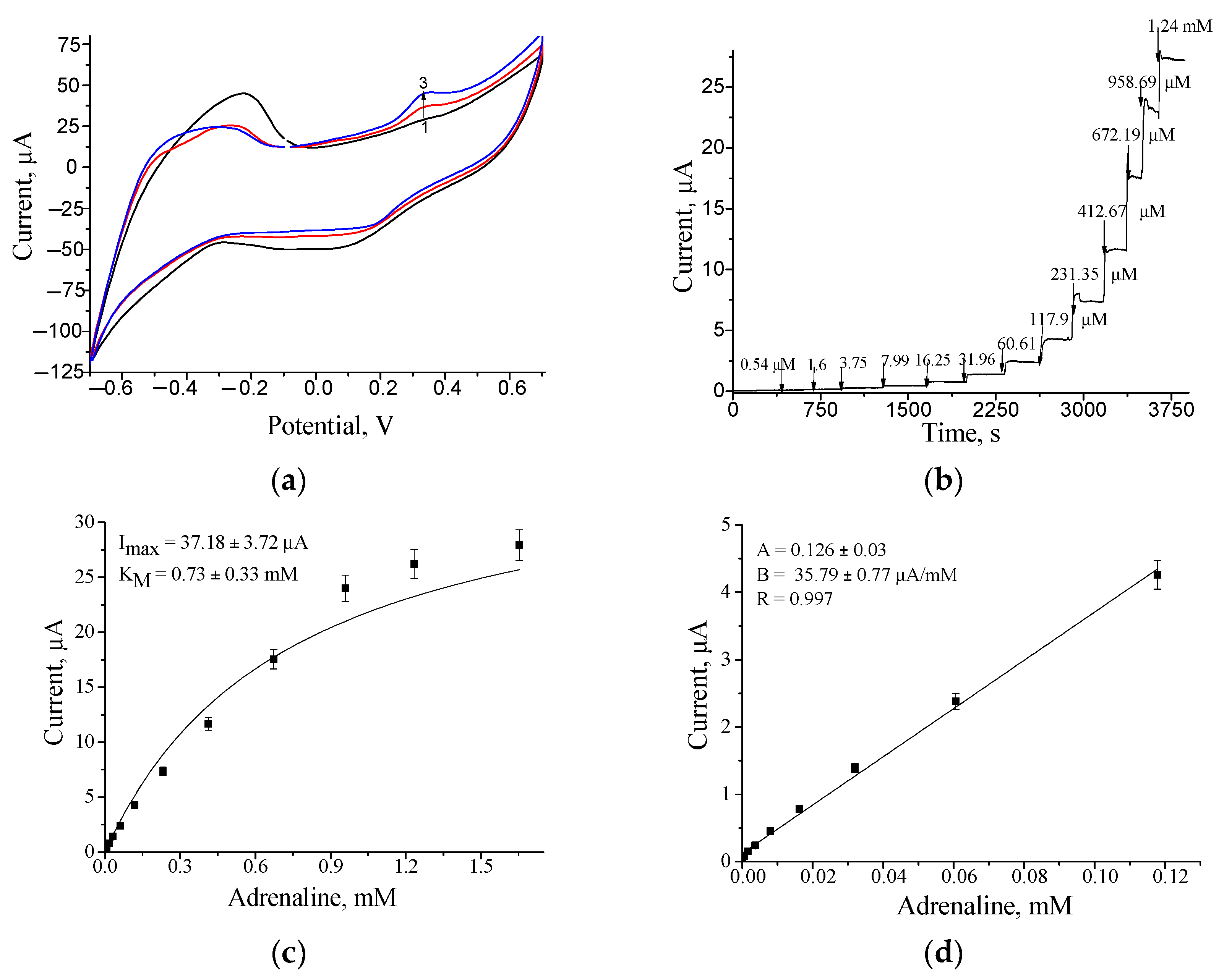
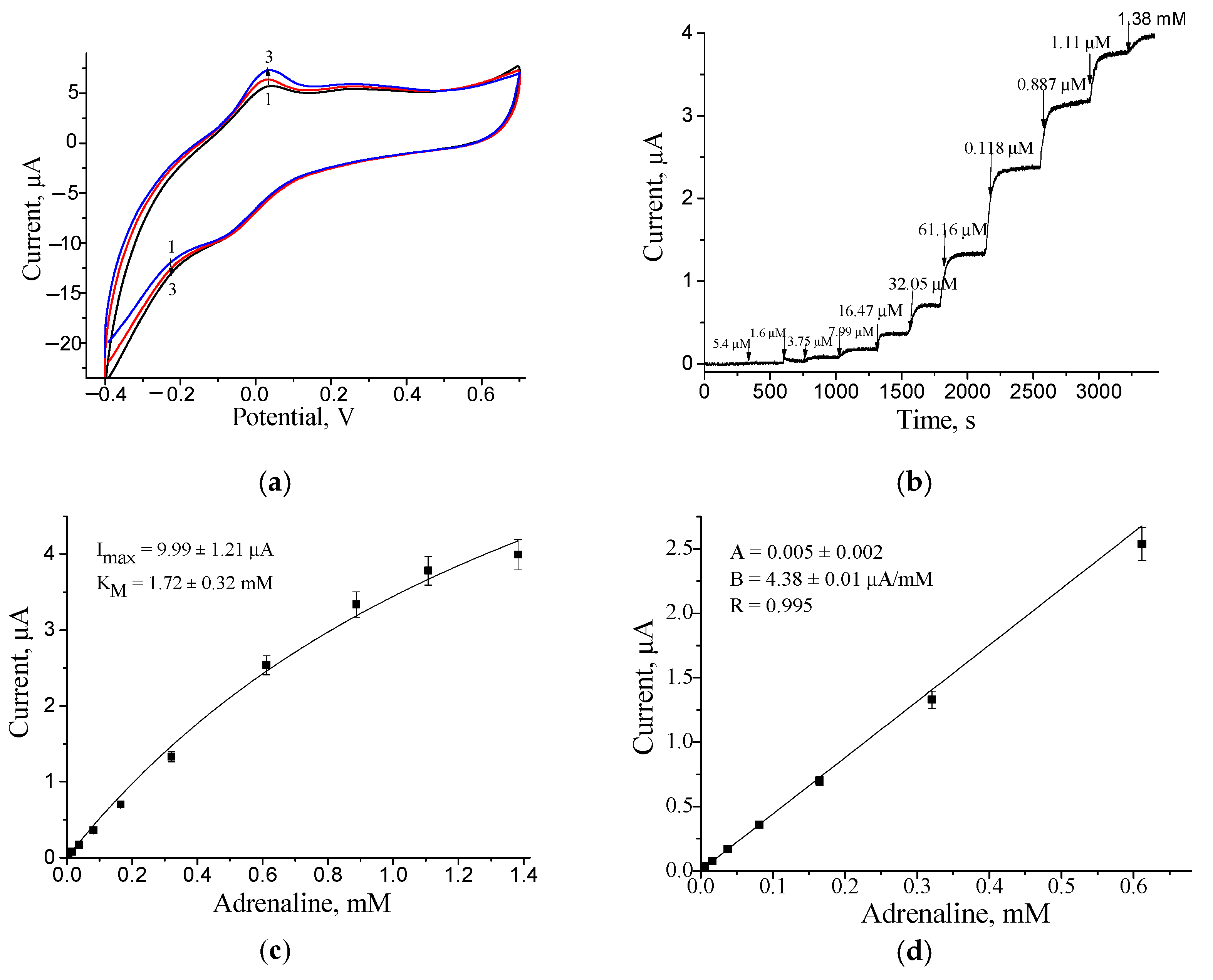
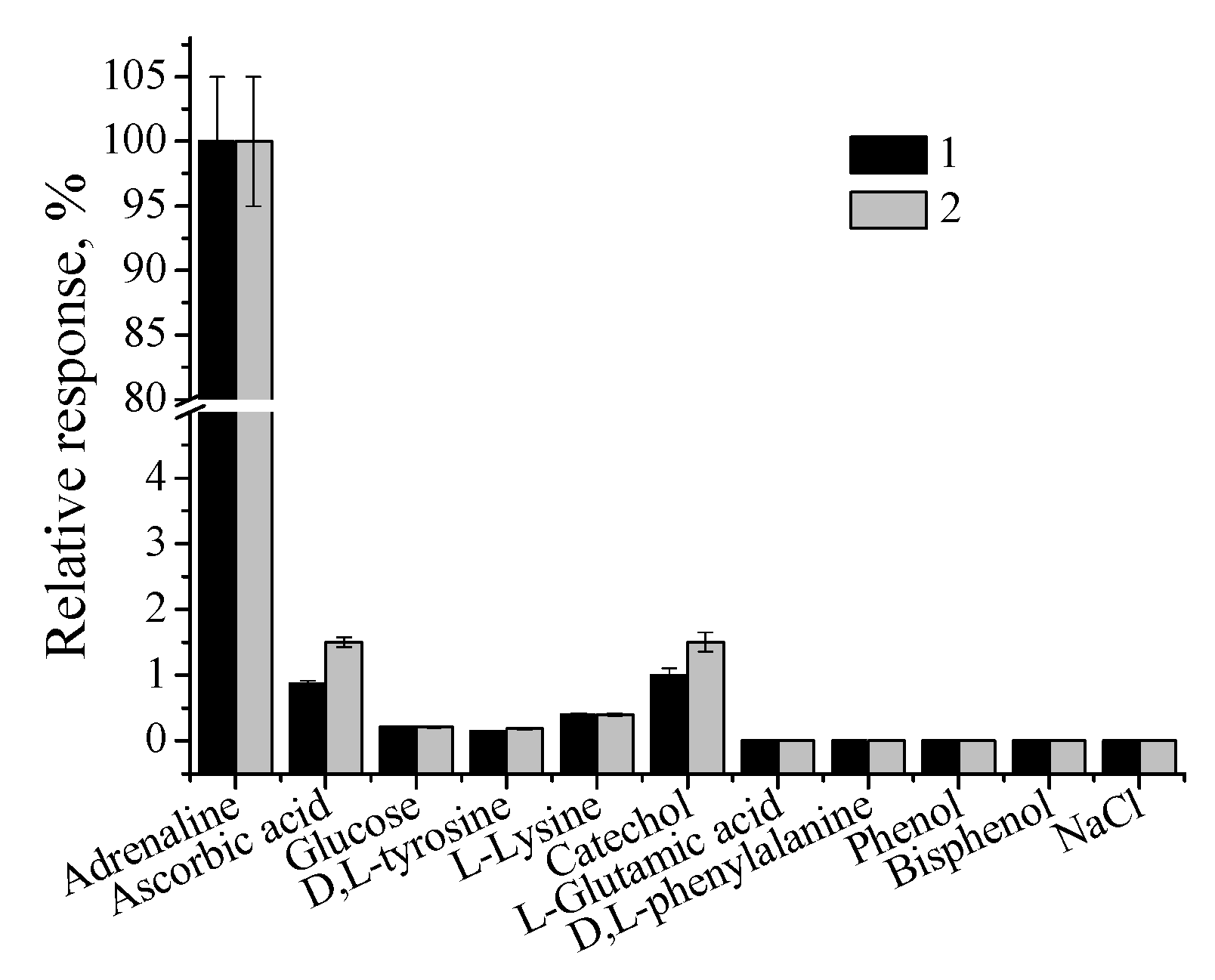

| No | NZ | Specific Activity, U·mg−1 |
|---|---|---|
| 1 | nAuCePt | 2.90 ± 0.25 |
| 2 | nAuCe | 0.85 ± 0.15 |
| 3 | nPtFe | 1.40 ± 0.10 |
| 4 | nFePtPd | 0.70 ± 0.05 |
| 5 | nAuPtPd | 0.30 ± 0.02 |
| 6 | nCoPtPd | 0.40 ± 0.02 |
| 7 | Laccase | 12.0 ± 0.11 |
| Sensing Element | Potential, mV | Sensitivity, A·M−1·m−2 | KMapp, mM | Linear Range, µM | LOD, µM | Reference |
|---|---|---|---|---|---|---|
| Laccase/PtNPs/PtE 1 | +50 | 3570 | – | up to 55 | 0.4 | [17] |
| Laccase/PPy-PVS 2/PtE | –220 | 8000 3 | 27 × 10−6 | 0.1–1.0 1–10 | 0.01 | [18] |
| AuNPs/PANi/GCE 4 | – | – | – | 0.4–40 | 0.08 | [19] |
| IrOx/SPE 5 | – | 30 | – | 0.1–15 | 0.03 | [20] |
| Graphite powder: laccase:Nujol: Pt-BMI.PF6 6/CPE 7 | – | – | – | 0.1–213 | 0.029 | [21] |
| Graphite powder–carbon nanotube–EBNBH 8 complex–paraffin/GCE 9 | +265 | – | – | 0.7–1200 | 0.216 | [22] |
| MWCNT/CFE 10 | –100 | 420 | – | up to 100 | 2 | [23] |
| Os-(PVP)10/Nafion/GCE | – | 316 | 0.51 | 2–113 | – | [24] |
| MWCNT-CoTSPc/GCE 6 | – | 1860 | – | 3.0–15 | 0.450 | [25] |
| MXene/GPE | +100 | – | – | 0.02–10 10–100 | 0.009 | [26] |
| Aminated graphene/AgNPs/GCE | +400 | – | – | 0.916–184 | 0.002 | [27] |
| Na[RuL2]/GCE | +100 | – | – | 27–136 | 35 | [28] |
| SP/Na[RuL2]/cellulose acetate/CE | - | 27–272 | 1.3 | |||
| SP/Na[RuL2]/MWCNTs/CE | - | 54–272 | 0.35 | |||
| nAuCePt/GE | –50 | 230,137 | 0.13 | 0.085–45 | 0.025 | Current work |
| nAuPtPd/GE | +250 | 10,137 | 0.11 | 0.530–32 | 0.5 | |
| nPtFe/GE | +250 | 4900 | 0.73 | 0.530–120 | 0.9 | |
| nFePtPd/GE | +250 | 3000 | 0.88 | 1.65–53 | 0.9 | |
| nCoPtPd/GE | +250 | 2950 | 0.66 | 1.65–61 | 0.9 | |
| Laccase/GE | +100 | 600 | 1.72 | 5–600 | 1.6 |
| Commercial Sample | Concentration of AD | CV, % | Producer | ||
|---|---|---|---|---|---|
| Estimated | Declared, % | ||||
| mM | % | ||||
| Adrenaline (Epinephrine) solution for injection, ampoule | 5.57 ± 0.25 | 0.185 | 0.180 | 2.7 | Pharmaceutical factory “Darnytsia”, Kyiv, Ukraine |
Publisher’s Note: MDPI stays neutral with regard to jurisdictional claims in published maps and institutional affiliations. |
© 2021 by the authors. Licensee MDPI, Basel, Switzerland. This article is an open access article distributed under the terms and conditions of the Creative Commons Attribution (CC BY) license (https://creativecommons.org/licenses/by/4.0/).
Share and Cite
Demkiv, O.; Stasyuk, N.; Gayda, G.; Gonchar, M. Highly Sensitive Amperometric Sensor Based on Laccase-Mimicking Metal-Based Hybrid Nanozymes for Adrenaline Analysis in Pharmaceuticals. Catalysts 2021, 11, 1510. https://doi.org/10.3390/catal11121510
Demkiv O, Stasyuk N, Gayda G, Gonchar M. Highly Sensitive Amperometric Sensor Based on Laccase-Mimicking Metal-Based Hybrid Nanozymes for Adrenaline Analysis in Pharmaceuticals. Catalysts. 2021; 11(12):1510. https://doi.org/10.3390/catal11121510
Chicago/Turabian StyleDemkiv, Olha, Nataliya Stasyuk, Galina Gayda, and Mykhailo Gonchar. 2021. "Highly Sensitive Amperometric Sensor Based on Laccase-Mimicking Metal-Based Hybrid Nanozymes for Adrenaline Analysis in Pharmaceuticals" Catalysts 11, no. 12: 1510. https://doi.org/10.3390/catal11121510







